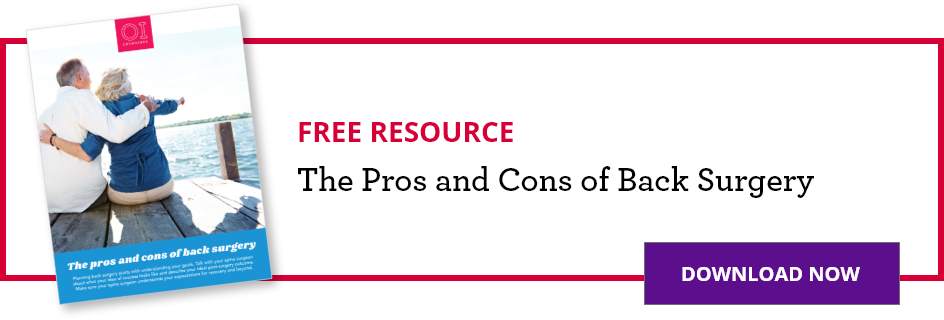THIS POST IS PART OF THE ULTIMATE GUIDE TO BACK PAIN RELIEF
Degenerative spondylolisthesis is a condition where the small joints between two bones of the low back have developed arthritis. In other words, they have worn out over time. This causes one bone to slide forward compared to the bone below. It most commonly occurs with the fourth lumbar vertebrae sliding forward on the fifth lumbar vertebrae and is more common in women than in men. It is a result of wear and tear over time and typically shows up when people are in their 50’s or older.
Cause
There are several ways in which this can cause someone pain. The first is the pain from the arthritis of the joints and the instability that comes with it. The second reason for pain is when the nerves become pinched. As the spine moves out of alignment, the path through the spine that carries the nerves becomes kinked. This can cause pain down the legs when the canal that carries the nerves through the low back narrows.
Several different things may cause the spinal canal in the low back to narrow. Common causes include bulging discs, herniated discs, arthritis, thickening of the ligament within the spine and a loss of spinal alignment with age. Lumbar stenosis typically occurs as a result of aging and the symptoms may develop slowly over time.
Symptoms
The back pain from the arthritis can be a sharp pain in the back just above the breast line. The discomfort from pinched nerves is often in the back, buttocks and legs with spinal stenosis. Quite often the symptoms are only in the legs. When we stand upright and walk, it tends to worsen the narrowing around the nerves and someone may experience pain, cramping or weakness when they try to walk. The symptoms typically get better quickly when they sit down. Leaning forward on a shopping cart or walker can reduce discomfort as well.
Physician examination
To determine whether you have spondylolisthesis your physician will ask you for a complete medical history and conduct a physical examination. An X-ray can confirm the diagnosis.
Make an appointment with an OrthoIndy spine surgeon
Spondylolisthesis treatment
Once someone develops pain they most commonly tend to have that pain unless it is treated. Roughly 10 percent of patients may have a spontaneous recovery and another 20 percent may have some worsening over time. The remaining 70 percent tend to have symptoms that do not particularly improve or worsen over time. Developing a paralysis or nerve injury is very rare unless someone has severe narrowing around their nerves or have had a sudden injury.
- Medications: The most effective medication to relieve the pain from arthritis or pinched nerves is a course of oral steroids such as Prednisone or Decadron. These medications can only be taken for several days at a time and the results are short lived. As a result they are used when pain is severe. Nerve medications, like Gabapentin and Lyrica may ease the nerve pain as well.They can have side effects of causing drowsiness, but these tend to improve after taking the medication for a few days. Anti-inflammatories, such as Motrin and Aleve, may be helpful. They function to reduce the inflammation on the nerve, just as steroids do, but they are not as strong as a steroid. These medications thin the blood and cannot be taken for a week prior to any injection or surgery. Pain medications such as Percocet and Norco tend to not reduce nerve pain. These medications are sometimes prescribed for short times as they may take the edge off the pain but most people are surprised by how little they help.
- Injections: Spinal injections can be very helpful. A spinal injection is a type of epidural that places steroid medication on the nerve where it is being pinched. This allows for a very high concentration of medicine right where it needs to be without the side effects of taking a high dose of steroid by mouth. The medicine stays active for approximately one month.The injections are very helpful in diagnosing exactly where pain is coming from in the spine. For patients that have long standing relief from injections, such as several a year, may be a good long-term treatment option. A common rule of thumb is that someone can have three injections a year for a spinal issue without significant risk of side effects (make an appointment with an OrthoIndy Non-operative Pain Management Physician).
- Physical Therapy: Therapy can help reduce the symptoms of spondylolisethsis by adding muscle strength that stabilizes the spine. Commonly it is prescribed for a month with a the recommendation that people continue to do strengthening on their own.
- Surgery: The surgeries for degenerative spondylolisthesis are very effective for reducing or eliminating the pain that stems from pressure on the nerves and instability. Many patients choose surgery when they have not had relief from the other nonsurgical treatments.
Learn more about treatment options for neck and back pain at OrthoIndy.
Schedule an appointment
Your well-being is important to us. Click the button below or call us to schedule an appointment with one of our orthopedic specialists. If your injury or condition is recent, you can walk right into one of our OrthoIndy Urgent Care locations for immediate care. For rehabilitation and physical therapy, no referral is needed to see one of our physical therapists.

Get the Ultimate Guide to Back Pain Relief
Our comprehensive guide will help you understand back pain and its different causes, like sciatica, herniated disk, scoliosis, pinched nerves and more.






